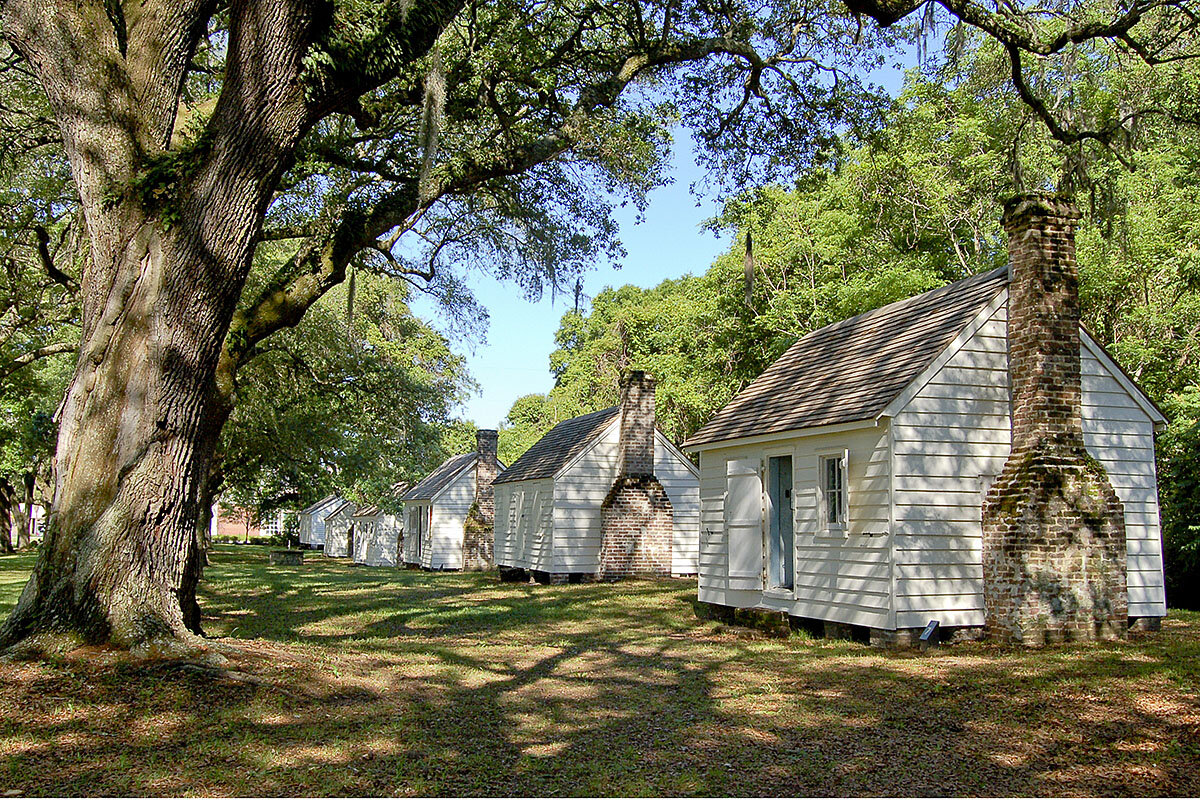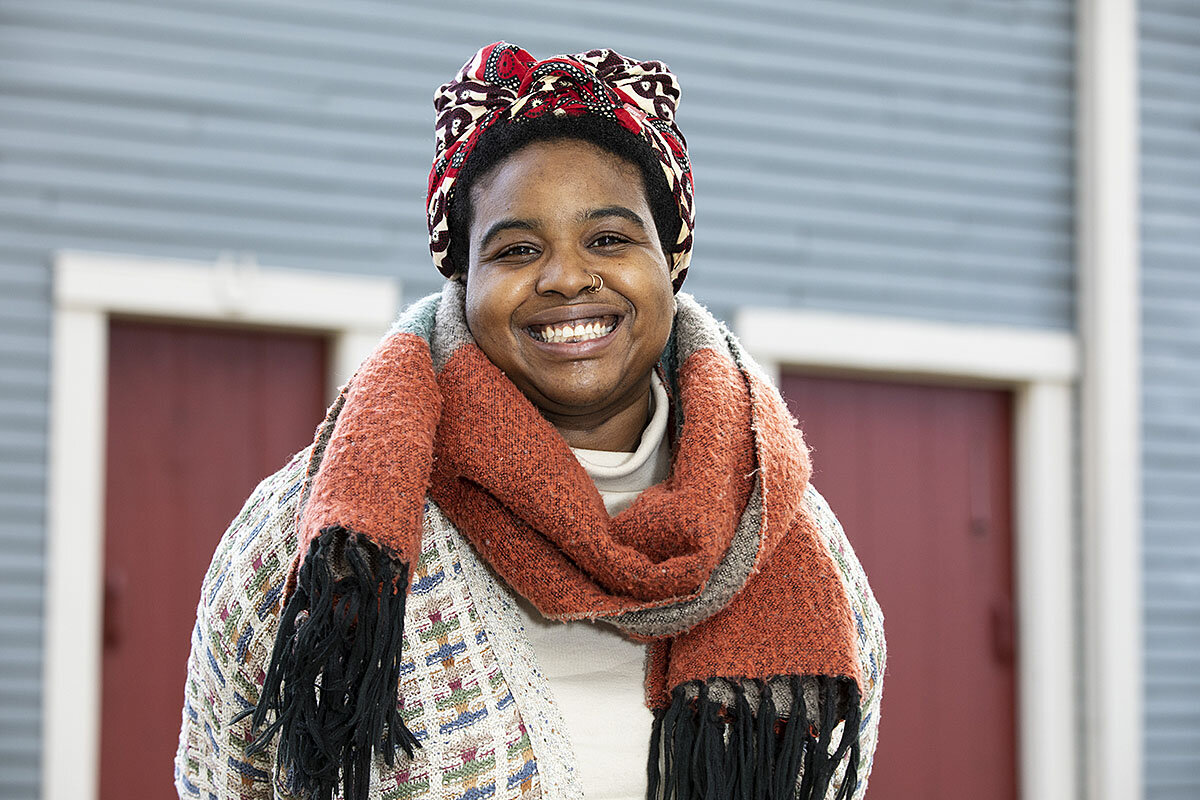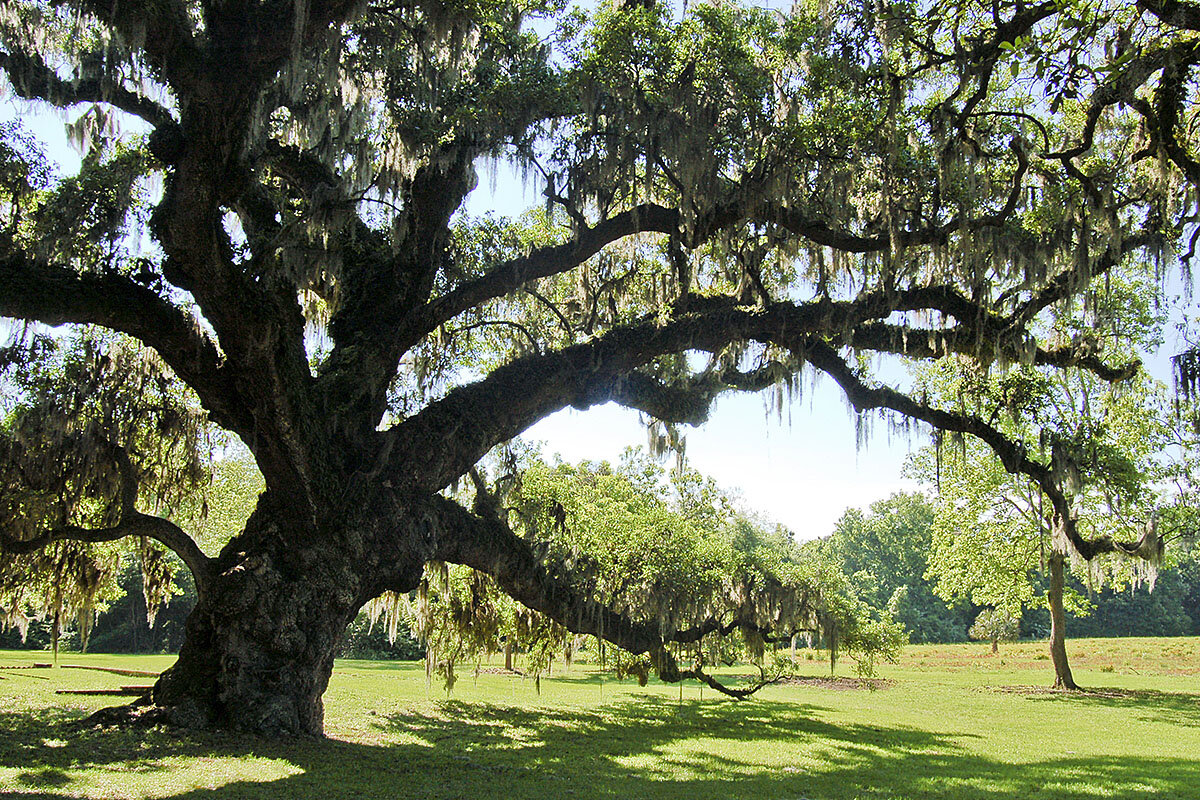Plantation tours bypass the ‘big house’ to focus on the enslaved
Loading...
Beside the long path to the Wappoo Creek stand symmetrical rows of Southern live oaks, arranged like the pillars of a temple. Down the dirt road below, shaded by the leaves and long beards of Spanish moss, Toby Smith leads her first tour of the morning to the Wappoo‚Äôs marshy banks. Then she asks them to look right.Ã˝
Miles away, past mud flats, fishing boats, and the Ashley River, sits Charleston, South Carolina. If they drifted on the water for about an hour, they‚Äôd hit the city harbor. If they floated past for another three months, she says, they‚Äôd arrive on the West Coast of Africa.Ã˝
That‚Äôs how Ms. Smith says she starts her tours of McLeod Plantation Historic Site, where she‚Äôs worked as a guide for the past two years. Her trip to the milky green waters of the Wappoo Creek is a regular pilgrimage, designed to help visitors imagine the journey of enslaved Africans who once stood on the same land. Starting near the water, she says, lets the tour walk in their footsteps.Ã˝
Why We Wrote This
By portraying slavery accurately and inclusively, some former plantations are doing their part to combat racial injustice. They hope letting the past inform the present will help heal “our nation’s greatest wound.”
For the next hour, Ms. Smith explains in a phone interview, she guides her group through the plantation grounds and lets them ask questions about its 37 acres. They pass the cramped slave quarters and palatial manor house. They pause at the slave cemetery and walk into the fields of sea island cotton, still growing. Inside the cotton gin house, they gaze at small dimples in the walls. Some days, Ms. Smith lets the group know that those are fingerprints left by enslaved children who hand-molded the bricks.Ã˝
“We are walking on the blood, sweat, and tears of real human beings,” she often tells visitors. “That has a very profound impact on people. ... Sometimes you don’t have to say anything. It’s just the presence.”
McLeod is among a growing number of sites that recognize the power of that presence. Its vision is to interpret the legacy of slavery, where slavery took place. Behind that, the focus is a recognition that the history of American slavery has been insufficiently and inaccurately told, often privileging the enslavers over the enslaved. Gradually, that‚Äôs changing as historians acknowledge that every life on plantations like McLeod mattered.Ã˝Ã˝
Reconstructing the lives of enslaved people is difficult, but from Wallace, Louisiana, to Medford, Massachusetts, many sites on the ground zero of slavery are accepting their role in that effort. Recent calls for racial justice have demanded a reckoning with wrongs that date back centuries. Places like McLeod harbor that history – and with it hope for catharsis.
“We are the stewards of spaces that can offer answers,” says Michelle Lanier, director of the North Carolina Division of State Historic Sites and Properties. “There’s a grand healing that I think is attempting to emerge through our nation’s greatest wound.”
‚ÄúBasically we‚Äôve been miseducated‚ÄùÃ˝
For many Americans, that wound has grown more painful with the way it has historically been taught, says Derrick Alridge, a professor at the University of Virginia‚Äôs Curry School of Education and Human Development.Ã˝
Dr. Alridge recently chaired Virginia‚Äôs Commission on African American History Education, charged with auditing the state‚Äôs efforts to teach Black history. Released last August, its 80-page identifies faults endemic to curricula across the country.Ã˝
Long dominant have been so-called master narratives, which teach American history through the lives of U.S. presidents or other “great men.” People of color – and especially African Americans – are often segregated into sections that cover only “messianic figures,” like the Rev. Martin Luther King Jr. Regular Black Americans, including enslaved people, are rarely given space.
“You can’t erase history. You can ignore it, which is something we’ve done for centuries,” says Jody Allen, an assistant professor of history at William & Mary in Williamsburg, Virginia. “There’s a real understanding that basically we’ve been miseducated in this country.”
Understanding the legacy of slavery, says Professor Alridge, is crucial to addressing its impacts today. Connecting historical dots ‚Äì from the Black Lives Matter movement to the civil rights movement to abolition ‚Äì puts the present in context and makes history real, he says.Ã˝
At a place like McLeod, where that history is as real as it can get, the stakes for getting it right are high.
Bypassing the “big house”
Just as the historical narrative has traditionally focused on the owning class, plantation museums have orbited the “big house,” says Shawn Halifax, cultural history interpretation coordinator for the Charleston County Park & Recreation Commission, which runs McLeod.
Typically, visitors marvel at the opulent homes of slave owners, he says, while enslaved people are treated as footnotes.Ã˝‚ÄúThe furnishing of these former dwellings oftentimes tends to create a type of nostalgia, which is the very thing that through our interpretation we‚Äôre trying to move beyond,‚Äù says Mr. Halifax.
At McLeod, the big house is empty, and the tour does not take visitors inside. Interpreters teach about William Wallace McLeod – the plantation’s owner and a Confederate soldier – but they focus on the 100 or so people enslaved on the site, telling their stories and saying their names.
More than 800 miles southwest, Whitney Plantation in Wallace, Louisiana, takes the same approach. Before the pandemic, the former sugar cane plantation attracted around 100,000 visitors each year, says Executive Director Ashley Rogers.
It, like McLeod, teaches slavery from the perspective of enslaved people and will soon empty its big house.Ã˝‚ÄúWe‚Äôre trying to use this plantation as a vehicle to get people to understand the system of slavery more broadly,‚Äù says Ms. Rogers.Ã˝Ã˝
One way they do that is by making sure Whitney’s history speaks to today. Only two of the original 22 slave quarters are still standing, but they aren’t relics. After the Civil War, many of Whitney’s enslaved people had little choice but to keep farming sugar cane and living in their same quarters. Some of their descendants stayed until 1975.
“Our entire point of what we’re trying to do is to teach people about the past so that they understand the present,” says Ms. Rogers. “If history doesn’t have an impact that you can still feel, then it’s just an interesting story.”
Seeing today through the lens of yesterday
Sometimes the past and the present collide.
Jennifer Stacy grew up near Charlottesville, Virginia, about 10 miles from Highland, the plantation of President James Monroe. Her family used to drive past the site on their way into town, and she would read the sign: Home of James Monroe. She knew about slavery, and she knew her grandfather was also a Monroe. Even as a girl, she sensed the two were somehow connected.Ã˝
Decades later, Ms. Stacy learned that she‚Äôs a descendant of Ned Monroe, an enslaved man at Highland who helped build the University of Virginia. Three years ago, she joined the estate‚Äôs newly formed , a group of 10 descendants who advise the site on its efforts to tell a fuller story.Ã˝
“It’s now shared authority, where the goal is to reinterpret the history there and to get it right,” Ms. Stacy says. “The true, deep-down hope is that this could be a roadmap to something bigger that our whole country can get behind and start doing, because it is who we are.”
Highland, like other plantation sites across the country, is researching the lives of those enslaved on its land ‚Äì constructing genealogies, reviewing oral histories, and panning streams of centuries-old documents. The task, though, requires swimming against the currents of history. Researchers engaged in this work often face a dearth of primary sources, low funds, and small staffs.Ã˝
This is especially true in the North.
Records show slavery is central to Northern states‚Äô histories. Benjamin Franklin, John Jay, andÃ˝Ã˝in the North who supported abolition owned slaves,Ã˝and New England colonies played a critical role in the transatlantic slave trade. There were enslaved people in every Rhode Island township, historians say, and local merchants bankrolled to West Africa during the Colonial period. All the other colonies combined sent 189.Ã˝
But Americans’ postbellum memory associates slavery almost exclusively with former Confederate states. Research on slavery outside the South is thin, and long-held notions of Northern heroism can chill attempts to learn more.
Correcting the record
“There is this great desire for people to want us to have made greater strides, but we are working against 50-plus years of America’s educational system,” says Lavada Nahon, interpreter of African American history for the New York State Office of Parks, Recreation and Historic Preservation.
While many sites in the North are adopting an approach similar to Whitney’s or McLeod’s, rediscovering an entire state’s role in slavery is a massive effort in historical forensics.
Artifacts have been mislabeled and misinterpreted, and important history has been lost in translation. In New York, this could mean translating early documents from Dutch to English or interpreting confusing terminology ‚Äì a recent paper published by the Schuyler Mansion State Historic Site in Albany argues that the ‚Äúservants‚Äù listed in Alexander Hamilton‚Äôs cash book were actually enslaved people. Even cursive handwriting can challenge the newer generation of historians.Ã˝
“It is not as if we are choosing not to honor our ancestors,” Ms. Nahon says. “It is time-consuming work.”
It‚Äôs also work that evolves. Heidi Hill, historic site manager at Schuyler Mansion, says the site has been compiling research on free and enslaved Africans since the 1980s. They‚Äôve long incorporated names, numbers, and the type of work enslaved people did into their tours and other events.Ã˝Ã˝
‚ÄúBut now we‚Äôre asking different questions,‚Äù says Ms. Hill.Ã˝‚ÄúWho were these people? Where did they come from? Who were their family members? How did they connect?‚Äù
Piecing together the lives of enslaved people
When communicating with a largely miseducated public, making the historical narrative more inclusive requires a powerful commitment.Ã˝
Kyera Singleton heard about the Royall House and Slave Quarters in Medford, Massachusetts, at a conference in 2019. She‚Äôd grown up in the Northeast, studied slavery, and still had no idea there were freestanding slave quarters in the North. But while the scholar in her wanted to visit, Ms. Singleton had a familiar fear: that the history would be whitewashed and the trip would be more painful than illuminating.Ã˝
Still, she decided to go and soon learned that the site had undergone a dramatic rebranding in 2005, bringing enslaved people into focus.
“Every room that we went in, we talked about the enslaved people,” she says. “It shows that their names matter, their lives matter, their history matters.”
Ms. Singleton was so impressed that she applied to work at the museum, and since April of last year, she has served as executive director. In her new role, Ms. Singleton is eager to uncover how the enslaved people who lived at the site experienced slavery, resisted it, and advocated for their freedomÃ˝‚Äì a challenging mission that includes archaeological and archival research, partnering with universities, and a lot of guesswork.Ã˝
“You might not find all of the information that you want,” she admits. “And that’s a part of the cruelty of history in many ways – whose lives were deemed important enough to document versus those whose lives were deemed unimportant.”
The paucity of first-person accounts of slavery has long been an excuse to avoid difficult conversations, says Cordell Reaves, historic preservation programs analyst for New York’s Office of Parks, Recreation and Historic Preservation.
“That is … a terrible disservice to the general public,” he says. “[Visitors] can be engaged in having a conversation around ongoing research, even if we are not absolutely certain about the outcome.”
Lately, Ms. Singleton has been working to increase the visibility of the Royall House and Slave Quarters, hoping to expand the site’s role in present-day social justice movements by helping communities understand that last year’s assaults against Black people, including by the police, were not unique.
“This history of injustice has been happening long before 2020,” says Ms. Singleton. “It will keep happening if we don’t actually confront systemic inequalities and racism in this country.”
Interrupting the cycle of history
The country has chosen not to confront the history before, and the history repeats. Generations come; generations go. The next sometimes forgets the last.Ã˝
But places like McLeod remember, says Ms. Smith, the interpreter near Charleston.Ã˝
Her tour ends, she says, at the Wisdom Oak, thought to be at least 200 years old. Ms. Smith asks her group to imagine what memories are caught in its branches.
Ms. Smith tells her group that she is a direct descendant of slaves, some of whom may have lived just 20 miles from McLeod. Her great-great-grandmother Idella was taken from modern-day Ghana in the 1840s, after the slave trade was illegal in America. Ms. Smith is alive today because Idella survived that voyage at the age of 8, mourned her losses alone, and started a family, living until 1941.Ã˝
This work is “a way for me to keep them alive, share their memories, and also to give them a measure of honor and dignity that they never had in life,” says Ms. Smith.
Then, at the roots of the Wisdom Oak, she tells her group about a visitor to McLeod six years ago. A month before Dylann Roof killed nine members of Emanuel African Methodist Episcopal Church in Charleston, South Carolina, he visited McLeod and took pictures of himself there.Ã˝
“People physically recoil at the fact that he was on the property,” says Ms. Smith. “But it gives us an opportunity to talk about hatred and why we cannot let hate end the conversation.”
There‚Äôs no agenda, no judgment, no attempt to sanitize what went on then or now, she says. It‚Äôs just a moment to pause, to acknowledge the pain, and to ask what they‚Äôll do about it.Ã˝
Maybe listen ‚Äì to each other, or the ancient oak above them.Ã˝
“Ultimately, we hope that it could be a place always of conversation and healing,” says Ms. Smith, “and people will leave better than when they came.”
Walter Houston Robinson contributed to this report.
Editor's note: This story has been updated to correct the title of Whitney Plantation Executive Director Ashley Rogers and the spelling of Derrick Alridge.








